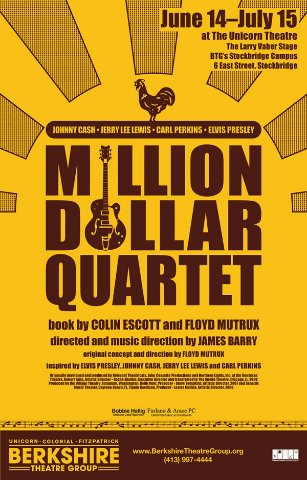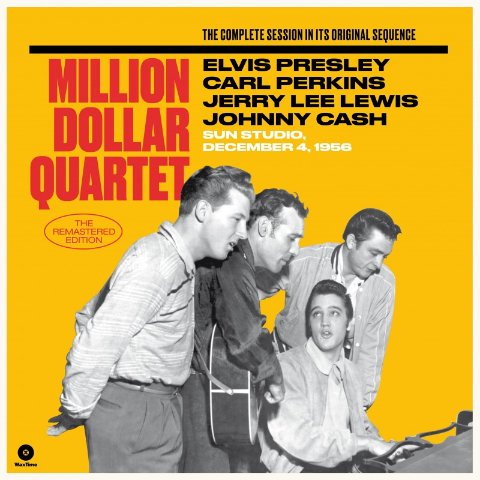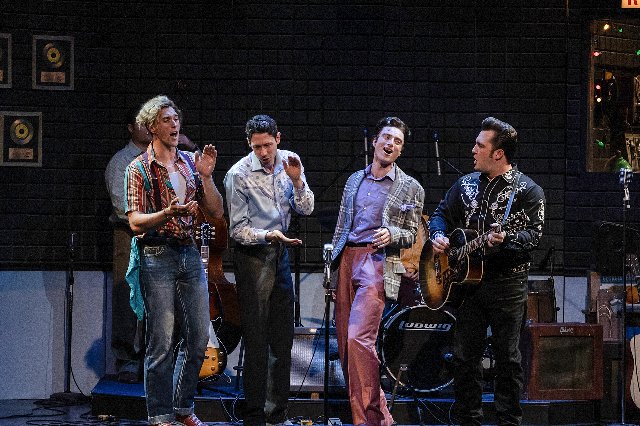Million Dollar Quartet in Pittsfield
Blows Roof off of Colonial Theatre
By: Charles Giuliano - Jun 30, 2023
Million Dollar Quartet
Book by Colin Escott and Floyd Mutrux
Original concept and direction by Floyd Mutrux
Inspired by Elvis Presley, Johnny Cash, Jerry Lee Lewis and Carl Perkins
Direction and choreography by Greg Santos
Musical direction by Colin Summers
Scenic design by Baron E. Pugh
Costume design by Arthur Oliver
Lighting design by José Santiago
Sound design by Nathan Leigh
Stage manager Sarah Kelso
Colonial Theatre
Berkshire Theatre Group
Through Sunday, July 16 at 2pm
Cast: Sam Phillips/ Zach Cossman, Jay Perkins/ Kroy Presley, Jerry Lee Lewis/ Billy Rude, Johnny Cash/ Bill Scott Sheets, Fluke/ Trey Snyder, Carl Perkins/ Colin Summers, Elvis Presley/ Alesandro Viviano, Dyane/ Emma Wilcox
By popular demand Berkshire Theatre Group has revised its immensely entertaining production of Million Dollar Quartet. It has relocated, mostly intact, from the small Unicorn in Stockbridge, to the gloriously more expansive Colonial Theatre in Pittsfield. On every level this version is larger than life.
How can it miss with recreations of four of the greatest musicians discovered and nurtured by Sam Phillips (Zach Cossman) in his miniscule but iconic Sun Records in Memphis. A brilliant producer, but lousy promoter, his recording studio was the epicenter of an emergence of rural Southern music from gospel, honkey tonk and country to rockabilly eliding with the roots of rock ‘n’ roll.
It’s Christmas time during the legendary sessions of December 4, 1956. Phillips is hosting a celebration noting the signing of a contract extension for Johnny Cash. To keep his faltering business afloat he had sold the contract of Elvis Presley to RCA Records for a paltry $40,000. The idea floats that he might be hired by RCA to produce Elvis.
Rounding out the quartet are Carl Perkins and an emerging tsunami of energy, Jerry Lee Lewis, who is eager to cut his first record for Phillips. Elvis arrives late with a then girlfriend Marilyn Evans who is a singer.
The remarkably accessible musical is constructed on an actual event. Posing the four for a photograph, Phillips wants proof as nobody will believe this actually happened. The CD is available on Amazon.
Phillips called a local newspaper which published an article and photograph the next day titled “Million Dollar Quartet.” Sun did not release the material from the eclectic jam session that entailed fragments of gospel music with Elvis on piano.
In 1969, Shelby Singleton bought Sun Records. He began a long search of the Sun catalogue, browsing through more than 10,000 hours of tape. At the same time, Singleton licensed much, if not all, of the Sun catalogue to the British Charly label for reissue in Europe. As a result of Singleton's and Charly's searches, a portion of the session came to light. This was issued in Europe in 1981 as "Charly/Sun" LP #1006 The Million Dollar Quartet, and it contained 17 tracks, focusing on gospel/spiritual music from the session.
Several years later, additional material was discovered. This resulted in the release of the 1987 "Charly/Sun" two-LP set #CDX 20 The Complete Million Dollar Session, together with their simultaneous issue in CD format in Europe. In 1990, they were replicated by RCA for US distribution as a CD and LP, titled, Elvis Presley: The Million Dollar Quartet (RCA CD # 2023-2-R).
What was a casual jam session, with friends dropping by during an official Carl Perkins session of a then new song “Matchbox,” has been formatted as the smash jukebox musical. The imminent demise of Sun Records threads through the bitcoin selections. While he had sold Elvis, and was about to loose Cash and Perkins to Columbia Records, he had an emerging star in Lewis and was about to sign another, Roy Orbison.
The genius of Phillips was that he was able to nurture and shape the essence of his artists. Elvis, then just 21, had come to him as a gospel trained, lounge crooner in the manner of Dean Martin. Phillips encouraged Presley to develop a blue-eyed soul style inspired by the black Memphis clubs which he frequented. With a swirl of his hips he put a pretty white face on black music.
Truth is the four musicians in this musical represented disparate genres and styles. It’s quite a feat to blend them into a uniform sound and evening of music. This is accomplished with varying degrees of success.
The set by Baron E. Pugh is simple to the point of drab. There is a curtain (brick wall) with two windows into the studio centered by the large Sun logo. That lifts to reveal a generic studio and recording booth in what was formerly an auto parts store. It’s a shoestring operation with Phillips on the road trying to get regional dj’s to spin the platters. There was zilch for marketing and distribution.
With 22 tunes it’s a rich evening of music. Each of the artists get their spotlight with the over-the-top Lewis (Billy Rude) overriding and camping up to the consternation of his mates. Like the original Lewis, he is all over, under, and around the piano. This is performed in the manner of Little Richard and later Elton John. For most of the session it’s a matter of keeping the phenomenal Rude on the leash. He is finally let loose with “Great Balls of Fire.” His hammering piano style is rooted in barrel house and boogie woogie with a sexy appeal to teens. He racked up seven spouses the first a 13-year-old cousin.
Carl Perkins, a musician’s musician is well represented by Colin Summers. He had a gold record with “Blue Suede Shoes.” There is bad blood with Phillips who allowed Elvis to perform it on the Ed Sullivan Show. Perkins it seemed never emerged from that shadow. Sparring with Rude, on raucous lead guitar, Summers lays down the hot licks. He solos on “See You Later Alligator” which was a 1956 hit for Bill Haley and the Comets. Among his best-known songs are "Blue Suede Shoes", "Honey Don't", "Matchbox" and "Everybody's Trying to Be My Baby".
The Perkins trio comprises slap style bass by Kroy Presley and the efficient Trey Snyder on drums. At times Presley kneels and strums the large instrument as though it were a guitar. It's a neat trick.
For my money, the most authentic of the musicians was Bill Scott Sheets as Johnny Cash. He was a melancholy, tormented, troubled man who conveyed his sorrow and abuses of life on the road through intensely personal music. With poignant restraint on acoustic guitar Sheets cloned Cash magnificently on the anthems “Folsom Prison Blues” and “I Walk the Line.” Cash was among the foremost country performers of his generation.
While it’s true to history that Elvis brought a girlfriend she makes minimal impact on the jam session. As a courtesy Dyanne (Emma Wilcox) is given a couple of solos and backup roles. Her rendering of Peggy Lee’s crisp and snappy “Fever” was way off the mark.
So what to say about Elvis (Allesandro Gian Viviano)? Truth is, not much. There was none of the charisma, flash, snarl and pimple popping sex appeal of the early Elvis. Here politely Presley blends in where he should be the elephant in the room. That signifier was boldly preempted by Rude.
The narrative ends with Cash and Perkins announcing their departures for Columbia Records.
There was a bow. Then the real fun broke loose. The studio disappeared and the musicians blasted through barn burners. With relentless energy the musicians finally got the sedentary, elderly audience up out of their seats. It was flat out fabulous and what Million Dollar Quartet is really all about. It just seems a pity that they saved dry powder for encores.



